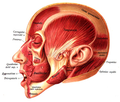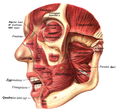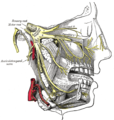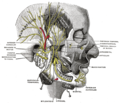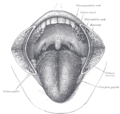Buccinator muscle
| Buccinator muscle | |
|---|---|
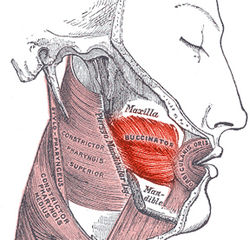 Buccinator outlined in red. | |
| Details | |
| Origin | From the alveolar processes of maxilla and mandible, buccinator crest and temporomandibular joint |
| Insertion | In the fibers of the orbicularis oris |
| Artery | Buccal artery |
| Nerve | Buccal branch of the facial nerve (VII cranial nerve) |
| Actions | The buccinator compresses the cheeks against the teeth and is used in acts such as blowing. It is an assistant muscle of mastication (chewing) and in neonates it is used to suckle. |
| Identifiers | |
| Latin | musculus buccinator[1] |
| TA98 | A04.1.03.036 |
| TA2 | 2086 |
| FMA | 46834 |
| Anatomical terms of muscle | |
The buccinator (/ˈbʌksɪneɪtər/[2][3]) is a thin quadrilateral muscle occupying the interval between the maxilla and the mandible at the side of the face. It forms the anterior part of the cheek or the lateral wall of the oral cavity.[4]
Structure
It arises from the outer surfaces of the alveolar processes of the maxilla and mandible, corresponding to the three pairs of molar teeth and in the mandible, it is attached upon the buccinator crest posterior to the third molar;[5] and behind, from the anterior border of the pterygomandibular raphe which separates it from the constrictor pharyngis superior.
The fibers converge toward the angle of the mouth, where the central fibers intersect each other, those from below being continuous with the upper segment of the orbicularis oris, and those from above with the lower segment; the upper and lower fibers are continued forward into the corresponding lip without decussation.
Innervation
Motor innervation is from the buccal branch of the facial nerve (cranial nerve VII). Sensory innervation is supplied by the buccal branch (one of the muscular branches) of the mandibular part of the trigeminal (cranial nerve V).[6]
Function
Its purpose is to pull back the angle of the mouth and to flatten the cheek area, which aids in holding the cheek to the teeth during chewing. This action causes the muscle to keep food pushed back on the occlusal surface of the posterior teeth, as when a person chews. By keeping the food in the correct position when chewing, the buccinator assists the muscles of mastication.[4]
It aids whistling and smiling, and in neonates it is used to suckle.
Structures piercing the buccinator
- Parotid duct (Stenson's duct)
- Molar glands of cheeks
- Buccal branch of mandibular nerve
Etymology
In the past the buccinator muscle was also written as bucinator muscle.[7] A bucinator in classical Latin is a trumpeter,[8] or more precisely, the person who blows the bucina.[8] The name bucina could refer in Roman antiquity to a crooked horn or trumpet,[8] a shepherd's horn[8] or a war-trumpet.[8] Despite its similarity to the classical Latin name for cheek, i.e. bucca,[8] the words bucinator, bucina, and bucinere (to blow the bucina[8]) are not related to bucca,[9] hence some disapproved the spelling buccinator.[9] Although the name bucinator is not derived from bucca, this muscle is also called musculus buccae [10] or musculus buccalis [7] in Latin and muscle of the cheek [10] in English.
The most recent official Latin anatomic nomenclature (Terminologia Anatomica),[11] and preceding editions (Nomina Anatomica)[12][13] [14][15] dictate the spelling 'musculus buccinator' with double 'c', with the exception of the Jena Nomina Anatomica, authorized in 1935, which writes 'musculus bucinatorius' [9] with a single 'c'.
Additional images
- Left maxilla, outer surface
- Mandible, outer surface, side view
- Scheme showing arrangement of fibers of orbicularis oris
- The internal carotid and vertebral arteries, right side
- Distribution of the maxillary and mandibular nerves and the submaxillary ganglion
- Mandibular division of the trifacial nerve
- The mouth cavity: The cheeks have been slit transversely and the tongue pulled forward.
- Position of buccinator muscle (red)
- Position of buccinator muscle (red)
- Position of buccinator muscle (red)
- Buccinator muscle
References
![]() This article incorporates text in the public domain from page 384 of the 20th edition of Gray's Anatomy (1918)
This article incorporates text in the public domain from page 384 of the 20th edition of Gray's Anatomy (1918)
- ^ TA A04.1.03.036
- ^ OED 2nd edition, 1989.
- ^ Entry "buccinator" in Merriam-Webster Online Dictionary.
- ^ a b Illustrated Anatomy of the Head and Neck, Fehrenbach and Herring, Elsevier, 2012, page 91
- ^ Google Books Woelfel's Dental Anatomy: Its Relevance to dentistry, Rickne C. Scheid, Julian B. Woelfel.
- ^ Grant's Dissector, Fourteenth Edition, page 204
- ^ a b F.D. Foster (1891–1893). An illustrated medical dictionary. Being a dictionary of the technical terms used by writers on medicine and the collateral sciences, in the Latin, English, French, and German languages. D. Appleton and Company.
- ^ a b c d e f g Lewis, C.T. & Short, C. (1879). A Latin dictionary founded on Andrews' edition of Freund's Latin dictionary. Oxford: Clarendon Press.
- ^ a b c Stieve, H. (1949). Nomina Anatomica. Zusammengestellt von der im Jahre 1923 gewählten Nomenklatur-Kommission, unter Berücksichtigung der Vorschläge der Mitglieder der Anatomischen Gesellschaft, der Anatomical Society of Great Britain and Ireland, sowie der American Association of Anatomists, überprüft und durch Beschluß der Anatomischen Gesellschaft auf der Tagung in Jena 1935 endgúltig angenommen. (4th edition). Jena: Verlag Gustav Fischer.
- ^ a b Schreger, C.H.Th.(1805). Synonymia anatomica. Synonymik der anatomischen Nomenclatur. Fürth: im Bureau für Literatur.
- ^ Federative Committee on Anatomical Terminology (FCAT) (1998). Terminologia Anatomica. Stuttgart: Thieme
- ^ International Anatomical Nomenclature Committee (1966). Nomina Anatomica. Amsterdam: Excerpta Medica Foundation.
- ^ International Anatomical Nomenclature Committee (1977). Nomina Anatomica, together with Nomina Histologica and Nomina Embryologica. Amsterdam-Oxford: Excerpta Med
- ^ International Anatomical Nomenclature Committee (1983). Nomina Anatomica, together with Nomina Histologica and Nomina Embryologica. Baltimore/London: Williams & Wilkins
- ^ International Anatomical Nomenclature Committee (1989). Nomina Anatomica, together with Nomina Histologica and Nomina Embryologica. Edinburgh: Churchill Livingstone.
External links
- "Anatomy diagram: 05287.011-1". Roche Lexicon - illustrated navigator. Elsevier. Archived from the original on 2013-04-22.
- "Anatomy diagram: 25420.000-1". Roche Lexicon - illustrated navigator. Elsevier. Archived from the original on 2015-02-26.
- Kang, HC; Kwak, HH; Hu, KS; Youn, KH; Jin, GC; Fontaine, C; Kim, HJ (2006). "An anatomical study of the buccinator muscle fibres that extend to the terminal portion of the parotid duct, and their functional roles in salivary secretion". J. Anat. 208 (5): 601–7. doi:10.1111/j.1469-7580.2006.00574.x. PMC 2100218. PMID 16637883.



